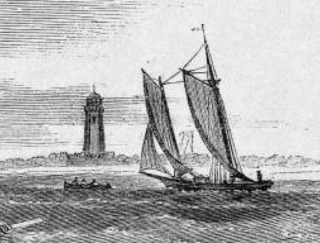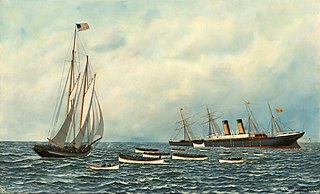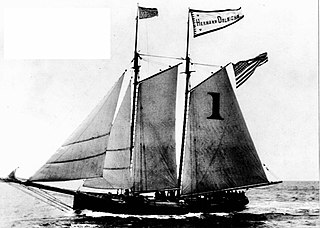
The Ellwood Walter, No. 7 was a 19th-century Sandy Hook pilot boat built in 1853 by Edward F. Williams at Greenpoint, Brooklyn to replace the pilot boat Yankee, which was lost in December 1852. The schooner was used to pilot vessels to and from the Port of New York. She was replaced by the Edmund Driggs, No. 7, in 1864.

The Columbia was a 19th-century pilot boat built C. & R. Poillon shipyard in 1879 for Sandy Hook and New York pilots that owned the Isaac Webb, which was lost off Quonochontaug Beach, Long Island in July 1879. She was run down by the Guion Line steamer SS Alaska in 1883. A second pilot-boat, also named Columbia, was built by Ambrose A. Martin at East Boston in 1894 that had a unique sppon bow and was extremely fast. She was thrown ashore in the great Portland Gale, and remained on the Sand Hills beach in Scituate, Massachusetts for over thirty years as a marine curiosity. The Louise No. 2 replaced the ill-fated Columbia.

The Phantom was a 19th-century Sandy Hook pilot boat built in 1867 from the designs by Dennison J. Lawlor. The schooner was considered a model for her type with a reputation for being very fast. She helped rescue the passengers on the steamship SS Oregon when it sank in 1886. She was one of the pilot-boats that was lost in the Great Blizzard of 1888. The Phantom was replaced by the pilot-boat William H. Bateman.

The Washington was a 19th-century Sandy Hook pilot boat built in 1845 by C. & R. Poillon for New York Pilots. She was rebuilt several times, the last with the sail number "22" painted on her mainsail. In 1884, she was sunk by the German steamship Roma, and then replaced by a new Washington.

The Francis Perkins, No. 13 was a 19th-century Sandy Hook pilot boat, built by Henry Steers in 1866 for a group of New York Pilots. She was considered one of the finest boats ever built. During a snow storm in 1887, the Perkins struck the steamship Aries and sank near the Barnegat shoals.

The Edward F. Williams was a 19th-century Sandy Hook pilot boat, built in 1863 at the Edward F. Williams shipyard in Greenpoint, Brooklyn for a group of New York Pilots. She survived the Great Blizzard of 1888. In the age of steam, the Williams was sold in 1896.

The James M. Waterbury was a 19th-century Sandy Hook pilot boat built in 1843, at Williamsburgh, Brooklyn for a group of New York Pilots. She helped on many of the rescues along the New York Harbor. One of last reports of the James M. Waterbury was in 1867 when seaman James Roach fell overboard and was drowned off Fire Island.
The Mary Ann, No. 13 was a 19th-century Sandy Hook pilot boat built for the New York pilots. She helped transport maritime pilots between inbound or outbound ships coming into the New York Harbor. In 1860, the Mary Ann, was one of only twenty-one pilot boats in the New York and New Jersey fleet. She went ashore outside Sandy Hook in 1863.

The Nettle was a 19th-century Sandy Hook pilot boat built in 1844 by S. Hall of East Boston, Massachusetts for the New York Pilots. She helped transport maritime pilots between inbound or outbound ships coming into the New York Harbor. In 1868, she found the wreck of the bark Henry Trowbridge, and towed her to Sandy Hook. The Nettle, sank in 1876 in the Pensacola Bay. The sunken wreck was removed in 1878 to improve the Pensacola harbor.

The Caprice was a 19th-century Sandy Hook pilot boat built in 1871 by Brown & Lovell in East Boston, Massachusetts for Peter McEnany and other New York pilots. In 1876, she was run down and sank, off Bay Ridge, Brooklyn, by the steamship New Orleans. She was raised and was one of the pilot boats that survived the Great Blizzard of 1888. The Caprice was last reported sailing off the coast of New York in 1891.

The David Carll was a 19th-century pilot boat, built in 1885 at the David Carll shipyard in City Island, New York. She was named in honor of David Carll, a well-known City Island shipbuilder. The David Carll was considered to be among the fastest schooners in the fleet. She was built to replace the Mary E. Fish that was run down and sank by the schooner Frank Harrington in 1885. She was one of the pilot boats that survived the Great Blizzard of 1888. The David Carll was lost at sea in 1893.

The Hermann Oelrichs was a 19th-century Sandy Hook Pilot boat, built in 1894 by Moses Adams at Essex, Massachusetts for a group of New York Pilots. She helped transport New York City maritime pilots between inbound or outbound ships coming into the New York Harbor. The Herman Oelrichs was said to be the fastest of the New York pilot fleet. She was built to replace the pilot boat Hope, that was wrecked in 1890.

The Mary E. Fish was a 19th-century Sandy Hook pilot boat, built at the Edward F. Williams shipyard of Greenpoint, Brooklyn in 1861 for Richard Brown and the New York Pilots. She was built to replace the Mary Taylor. The Fish was hit and sank by the schooner Frank Harrington in 1885 and replaced by the David Carll.

Charlotte Webb was a 19th-century New York City pilot boat built in 1865 at the Webb & Bell shipyard to take the place of the James Funk, that was destroyed by the rebel Tallahassee during the Civil War. She survived the Great Blizzard of 1888, but was run down by the French steamship La Normandie in 1889. She was replaced by the pilot boat George H. Warren.
The Mary and Catherine was a 19th-century New York pilot boat built in 1848 by the Jacob Aaron Westervelt shipyard. She was hit and sunk by the steamship Haverton in 1885. The collision was the subject of a court case that went to the Supreme Court of the United States as Devere v. The Haverton. The Mary and Catherine was replaced by the pilot boat William H. Starbuck.

The Enchantress was a 19th-century Sandy Hook pilot boat built in 1851 by John Maginn who named her after one of the cast in the opera The Enchantress. She was launched from the Westervelt & McKay shipyard. The Enchantress was one of the oldest pilot-boats in the service. She was Cornelius Vanderbilt's favorite pilot boat. The Enchantress went down with all hands in the Great Blizzard of 1888. The pilot boat James Stafford was built to replace her.
The Blossom was a 19th-century Sandy Hook pilot boat built for the New York pilots around 1837. She helped transport maritime pilots between inbound or outbound ships coming into the New York Harbor. In 1839, she came across the Slave ship La Amistad. In 1840, there were only eight New York pilot boats, the Blossom being No. 5. Pilot Thomas Freeborn of the Blossom boarded the packet ship John Minturn and tried to guide the ship in bad weather. He was one of thirty-eight passengers that died near the Jersey Shore in 1846.

The Coquette was a 19th-century yacht and pilot boat, built in 1845 by Louis Winde, at the Winde & Clinkard shipyard in Chelsea, Massachusetts for yachtsmen James A. Perkins. Her design was based on a model by shipbuilder Dennison J. Lawlor. The Coquette was a good example of an early American yacht with a clipper bow. As a yacht, she won the attention for outsailing the larger New York yacht Maria at the second New York Yacht Club regatta in 1846. Perkins sold the Coquette to the Boston Pilots' Association for pilot service in 1848. She continued as a pilot boat until 1867 when she was sold as a Blackbirder to be used on the African coast.
The E. K. Collins was a 19th-century Sandy Hook pilot boat built in the early 1840s. She was named for the American shipping magnate Edward Knight Collins. During a winter storm, the Collins ran ashore on the outer bar of Fire Island in 1856.














